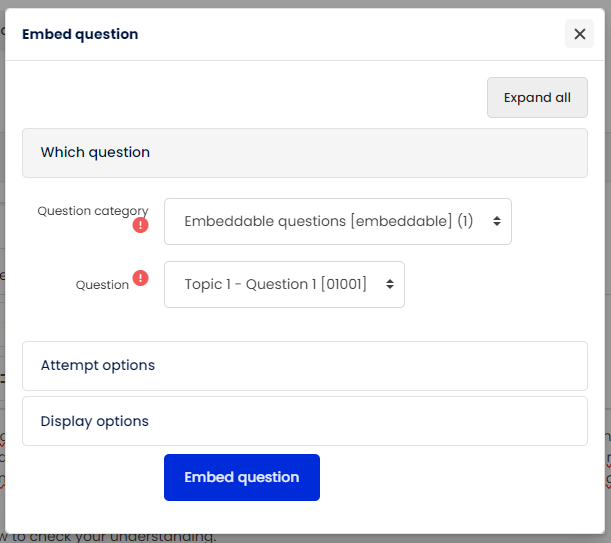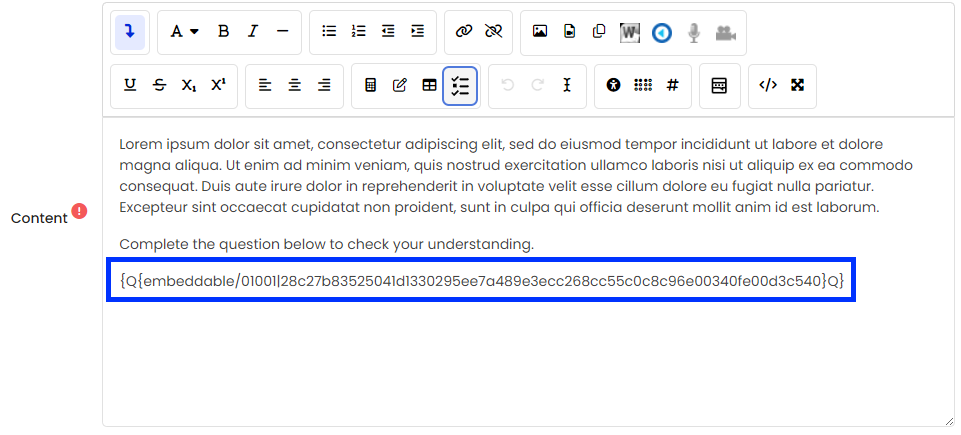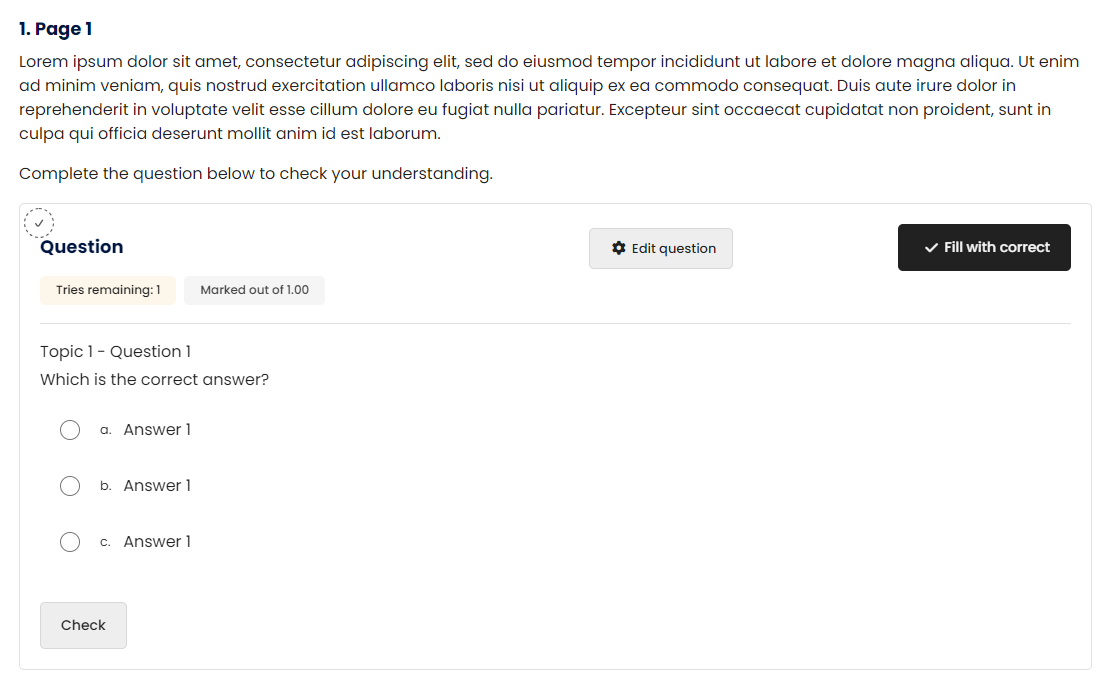Embedding questions from the Moodle Question bank
Questions from the Moodle Question bank can be embedded anywhere on a Moodle site where the text editor is available. For example, embedding questions within a Moodle Book or Page makes the subject content more interactive, encouraging active learning and reflection.
Data on students’ responses to questions embedded from the Moodle Question bank is not captured, making these questions best suited for formative activities. Since they cannot be graded, providing detailed and constructive feedback is essential to help students assess their understanding and identify areas for improvement.
Why?
Embedding questions throughout subject content allows students to practice their skill and/or test their understanding as they interact with subject content. Continuous, specific feedback provided through formative tasks supports better understanding of learning objectives and improves student outcomes (Adarkwah, 2021). Quality feedback also helps students identify strengths and areas for improvement, promoting self-regulated learning (Ahea et al., 2016; Narciss, 2023).
Another valid use case involves embedding questions within activities like H5P, Padlet, or Echo Active Learning Platform (ALP), enhancing their interactivity.
Wherever these questions are embedded, their appearance mirrors what students encounter in Moodle quizzes and exams. This consistent interface fosters familiarity with the quiz process, building students’ confidence and reinforcing their performance in summative assessments.
How?
Creating questions
To embed a question, the following conditions must be met:
- The question must be housed in the Question bank for the subject site.
Note: For guidance on creating questions in the Question bank, refer to the Moodle Quiz questions collection. - The question must have an ID number.
- The category containing the question in the Question bank must also have an ID number.
Note: While this field in Moodle is referred to as an ID number, it does not need to be numerical. A keyword or phrase can be used to label the category or question for better organisation of your Question bank.
To maintain consistency, consider using a standard convention for ID numbers. For example, you could create a category in your Question bank called 'Embeddable questions' with the ID number 'embeddable'. Within this category, questions could be titled 'Topic 1 – Question 1' ‘Topic 1 – Question 2’ with id numbers '0101' and ‘0102’, respectively.
Embedding questions
You can embed a question anywhere in Moodle that allows input of HTML. For this example, we will use a page within a Moodle Book activity.
- Ensure Edit mode is on.
- Navigate to where you would like to embed the question in your subject site.
- In the text editor, click the Show more button, then click the Embed question button.

- Select the relevant Question category from your Question bank in the Embed question pop-up window.
Note: If no categories are available to select, ensure both the category and the question within it have ID numbers in the Question bank. Refer to the Creating questions section above for guidance. - Select the relevant Question from the dropdown menu, or select the Choose an embeddable question from this category randomly option.

- Review the Attempt options and Display options sections, adjusting settings as required.
- Click the Embed question button.
Note: The embedded question will display as a code while you're still in the text editor – do not modify this code. When you've finished editing and save the page, the code will be replaced and the embedded question will display.

Analytics
Responses from embedded questions are not recorded in the Moodle Gradebook. However, a limited report can be accessed by selecting the Embedded questions progress option from the Activity settings menu.
This report provides an overview of all students' Last attempt status ("Correct", "Incorrect", or "Not yet answered") for all embedded questions. Clicking on the timestamp in the Latest attempt column for a student will display additional information about their attempts.

References
Adarkwah, M.A. The power of assessment feedback in teaching and learning: a narrative review and synthesis of the literature. SN Soc Sci 1, 75 (2021). https://doi.org/10.1007/s43545-021-00086-w
Ahea, Md. M.-A.-B., Ahea, Md. R. K., & Rahman, I. (2016). The Value and Effectiveness of Feedback in Improving Students’ Learning and Professionalizing Teaching in Higher Education. Journal of Education and Practice, 7(16), 38-.
Narciss, S., Zumbach, J. (2023). Formative Assessment and Feedback Strategies. In: Zumbach, J., Bernstein, D.A., Narciss, S., Marsico, G. (eds) International Handbook of Psychology Learning and Teaching. Springer International Handbooks of Education. Springer, Cham. https://doi.org/10.1007/978-3-030-28745-0_63
The information provided in this resource has been modified and contextualised for UOW purposes from the following sources:



